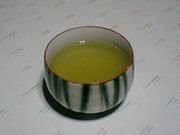
When the term "nanotechnology" was independently coined and popularized by Eric Drexler (who at the time was unaware of an earlier usage by Norio Taniguchi) it referred to a future manufacturing technology based on molecular machine systems. The premise was that molecular scale biological analogies of traditional machine components demonstrated molecular machines were possible: by the countless examples found in biology, it is known that sophisticated, stochastically optimised biological machines can be produced..
It is hoped that developments in nanotechnology will make possible their construction by some other means, perhaps using biomimetic principles. However, Drexler and other researchers[2] have proposed that advanced nanotechnology, although perhaps initially implemented by biomimetic means, ultimately could be based on mechanical engineering principles, namely, a manufacturing technology based on the mechanical functionality of these components (such as gears, bearings, motors, and structural members) that would enable programmable, positional assembly to atomic specification (PNAS-1981). The physics and engineering performance of exemplar designs were analyzed in Drexler's book Nanosystems.
In general it is very difficult to assemble devices on the atomic scale, as all one has to position atoms are other atoms of comparable size and stickyness. Another view, put forth by Carlo Montemagno,[3] is that future nanosystems will be hybrids of silicon technology and biological molecular machines. Yet another view, put forward by the late Richard Smalley, is that mechanosynthesis is impossible due to the difficulties in mechanically manipulating individual molecules.
This includes subfields which develop or study materials having unique properties arising from their nanoscale dimensions.[6]
Interface and Colloid Science has given rise to many materials which may be useful in nanotechnology, such as carbon nanotubes and other fullerenes, and various nanoparticles and nanorods.
Nanoscale materials can also be used for bulk applications; most present commercial applications of nanotechnology are of this flavor.
Progress has been made in using these materials for medical applications; see Nanomedicine.






